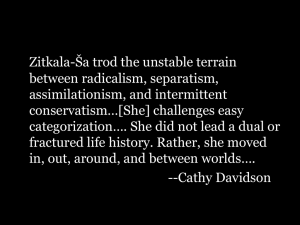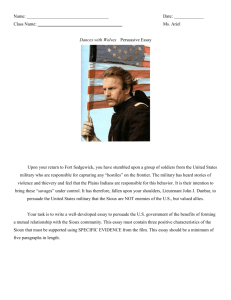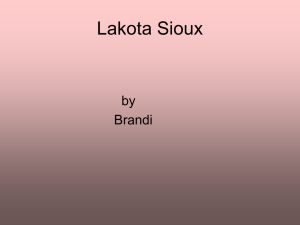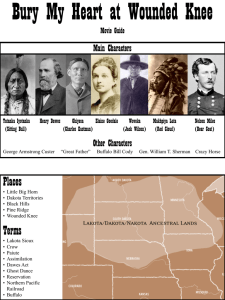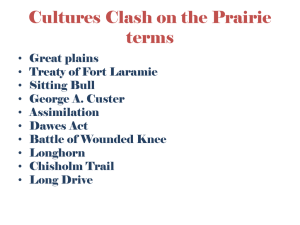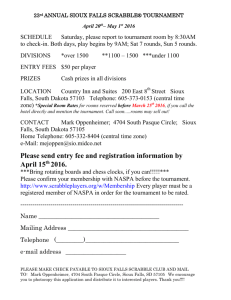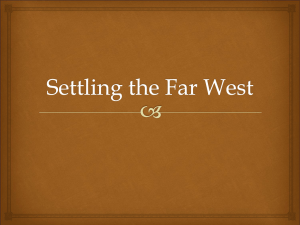The Canadian Sioux, Second Edition
advertisement
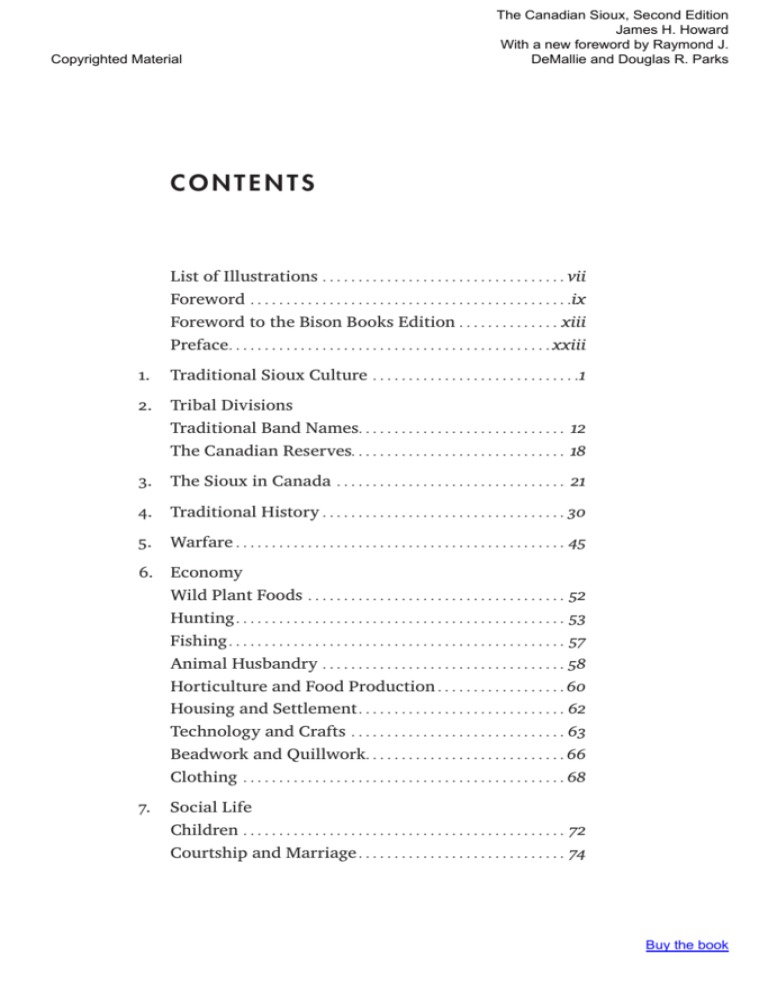
7KH&DQDGLDQ6LRX[6HFRQG(GLWLRQ -DPHV++RZDUG :LWKDQHZIRUHZRUGE\5D\PRQG- 'H0DOOLHDQG'RXJODV53DUNV &RS\ULJKWHG0DWHULDO CONTENTS List of Illustrations . . . . . . . . . . . . . . . . . . . . . . . . . . . . . . . . . . vii Foreword . . . . . . . . . . . . . . . . . . . . . . . . . . . . . . . . . . . . . . . . . . . . .ix Foreword to the Bison Books Edition . . . . . . . . . . . . . . xiii Preface. . . . . . . . . . . . . . . . . . . . . . . . . . . . . . . . . . . . . . . . . . . . . xxiii 1. Traditional Sioux Culture 2. Tribal Divisions . . . . . . . . . . . . . . . . . . . . . . . . . . . . .1 Traditional Band Names. . . . . . . . . . . . . . . . . . . . . . . . . . . . . 12 The Canadian Reserves. . . . . . . . . . . . . . . . . . . . . . . . . . . . . . 18 3. The Sioux in Canada 4. Traditional History . . . . . . . . . . . . . . . . . . . . . . . . . . . . . . . . . . 30 5. Warfare . . . . . . . . . . . . . . . . . . . . . . . . . . . . . . . . . . . . . . . . . . . . . . 45 ................................ 21 6. Economy Wild Plant Foods . . . . . . . . . . . . . . . . . . . . . . . . . . . . . . . . . . . . 52 Hunting . . . . . . . . . . . . . . . . . . . . . . . . . . . . . . . . . . . . . . . . . . . . . . 53 Fishing . . . . . . . . . . . . . . . . . . . . . . . . . . . . . . . . . . . . . . . . . . . . . . . 57 Animal Husbandry . . . . . . . . . . . . . . . . . . . . . . . . . . . . . . . . . . 58 Horticulture and Food Production . . . . . . . . . . . . . . . . . . 60 Housing and Settlement . . . . . . . . . . . . . . . . . . . . . . . . . . . . . 62 Technology and Crafts . . . . . . . . . . . . . . . . . . . . . . . . . . . . . . 63 Beadwork and Quillwork. . . . . . . . . . . . . . . . . . . . . . . . . . . . 66 Clothing . . . . . . . . . . . . . . . . . . . . . . . . . . . . . . . . . . . . . . . . . . . . . 68 7. Social Life Children . . . . . . . . . . . . . . . . . . . . . . . . . . . . . . . . . . . . . . . . . . . . . 72 Courtship and Marriage . . . . . . . . . . . . . . . . . . . . . . . . . . . . . 74 %X\WKHERRN &RS\ULJKWHG0DWHULDO 7KH&DQDGLDQ6LRX[6HFRQG(GLWLRQ -DPHV++RZDUG :LWKDQHZIRUHZRUGE\5D\PRQG- 'H0DOOLHDQG'RXJODV53DUNV Kinship System . . . . . . . . . . . . . . . . . . . . . . . . . . . . . . . . . . . . . . 77 Visiting . . . . . . . . . . . . . . . . . . . . . . . . . . . . . . . . . . . . . . . . . . . . . . 82 Athletic Sports. . . . . . . . . . . . . . . . . . . . . . . . . . . . . . . . . . . . . . . 83 Gambling Games . . . . . . . . . . . . . . . . . . . . . . . . . . . . . . . . . . . . 84 Social Dances . . . . . . . . . . . . . . . . . . . . . . . . . . . . . . . . . . . . . . . . 87 8. Philosophy and Religion Supernatural Beings . . . . . . . . . . . . . . . . . . . . . . . . . . . . . . . . . 98 Folktales . . . . . . . . . . . . . . . . . . . . . . . . . . . . . . . . . . . . . . . . . . . . 104 Magic . . . . . . . . . . . . . . . . . . . . . . . . . . . . . . . . . . . . . . . . . . . . . . . 105 Doctoring . . . . . . . . . . . . . . . . . . . . . . . . . . . . . . . . . . . . . . . . . . . 107 Death and Burial . . . . . . . . . . . . . . . . . . . . . . . . . . . . . . . . . . . .112 9. Ceremonialism, the Woodlands Heritage Vision Quest . . . . . . . . . . . . . . . . . . . . . . . . . . . . . . . . . . . . . . . . . 115 Prayer Feast and Medicine Feast . . . . . . . . . . . . . . . . . . . .117 Adoption Feast . . . . . . . . . . . . . . . . . . . . . . . . . . . . . . . . . . . . . 119 Medicine Dance . . . . . . . . . . . . . . . . . . . . . . . . . . . . . . . . . . . . 120 Animal Dreamers . . . . . . . . . . . . . . . . . . . . . . . . . . . . . . . . . . . 128 10. Ceremonialism, the Plains Heritage Sun Dance . . . . . . . . . . . . . . . . . . . . . . . . . . . . . . . . . . . . . . . . . . 129 Horse Dance . . . . . . . . . . . . . . . . . . . . . . . . . . . . . . . . . . . . . . . . 132 Warrior Society Dances . . . . . . . . . . . . . . . . . . . . . . . . . . . . 133 Grass Dance . . . . . . . . . . . . . . . . . . . . . . . . . . . . . . . . . . . . . . . . 135 Thachó, Warbonnet, and Buffalo Dances . . . . . . . . . . 162 Heyókha Dance . . . . . . . . . . . . . . . . . . . . . . . . . . . . . . . . . . . . . 163 Ghost Dance . . . . . . . . . . . . . . . . . . . . . . . . . . . . . . . . . . . . . . . . 165 Peyote Religion . . . . . . . . . . . . . . . . . . . . . . . . . . . . . . . . . . . . . 170 11. The Canadian Sioux Today . . . . . . . . . . . . . . . . . . . . . . . . . .171 Appendix: List of Informants. . . . . . . . . . . . . . . . . . . . . . . 179 Bibliography . . . . . . . . . . . . . . . . . . . . . . . . . . . . . . . . . . . . . . . . .181 Index . . . . . . . . . . . . . . . . . . . . . . . . . . . . . . . . . . . . . . . . . . . . . . . . 185 %X\WKHERRN 7KH&DQDGLDQ6LRX[6HFRQG(GLWLRQ -DPHV++RZDUG :LWKDQHZIRUHZRUGE\5D\PRQG- 'H0DOOLHDQG'RXJODV53DUNV &RS\ULJKWHG0DWHULDO I L L U S T R AT I O N S PHOTO GRA PH S 1. Sioux Ben, Birdtail, ca. 1920 2. Frank Merrick and Family, ca. 1922 . . . . . . . . . . . . . . . . . 37 3. Frank Merrick, 1972 4. Gray Eagle Woman, Wahpeton, 1946 5. Arthur Young, Oak Lake, 1972 ........................ ................................ 38 ............... 41 ...................... 54 6. Frank Merrick farming, Long Plains, ca. 1927 7. 33 ...... 61 Tipis, Moose Woods, 1972 . . . . . . . . . . . . . . . . . . . . . . . . . . . 64 8. Three men, Devils Lake, ca. 1900 . . . . . . . . . . . . . . . . . . . 69 9. Grass dancers, Standing Buffalo, 1972 .............. 78 10. Grass dancers, Standing Buffalo, 1972 .............. 78 11. Grass dancers, Standing Buffalo, 1972 . . . . . . . . . . . . . . 79 12. Giveaway, White Cap, 1972 . . . . . . . . . . . . . . . . . . . . . . . . . 80 13. Archie Eagle, White Cap, 1972 . . . . . . . . . . . . . . . . . . . . . . 90 14. Wakháŋ wachípi, Oak River, 1929 . . . . . . . . . . . . . . . . . . 123 15. Plains Ojibwa and Dakota dancers, 1929 .......... 137 16. Grass dancers, 1952. . . . . . . . . . . . . . . . . . . . . . . . . . . . . . . . . 137 17. Powwow parade, Sioux Valley, 1972 . . . . . . . . . . . . . . . 154 18. Grass dancers, Sioux Valley, 1972 . . . . . . . . . . . . . . . . . . 154 %X\WKHERRN 7KH&DQDGLDQ6LRX[6HFRQG(GLWLRQ -DPHV++RZDUG :LWKDQHZIRUHZRUGE\5D\PRQG- 'H0DOOLHDQG'RXJODV53DUNV &RS\ULJKWHG0DWHULDO 19. Grass dancers, Sioux Valley, 1972 . . . . . . . . . . . . . . . . . . 155 20. Grass dancers, Sioux Valley, 1972 . . . . . . . . . . . . . . . . . . 156 21. Grass dancers, Sioux Valley, 1972 . . . . . . . . . . . . . . . . . . 157 22. Women and girls, Sioux Valley, 1972 . . . . . . . . . . . . . . . 158 23. Women and girls, Sioux Valley, 1972 . . . . . . . . . . . . . . . 159 24. Women and girls, Sioux Valley, 1972 . . . . . . . . . . . . . . . 159 MAP Canadian Sioux reserves . . . . . . . . . . . . . . . . . . . . . . . . . . . . xx F I GU R E S 56 1. Technique employed by Sioux hunters 2. Song board 3. Grass dance whips . . . . . . . . . . . . . . . . . . . . . . . . . . . . . . . . . . 141 ............. ......................................... 127 %X\WKHERRN &RS\ULJKWHG0DWHULDO 7KH&DQDGLDQ6LRX[6HFRQG(GLWLRQ -DPHV++RZDUG :LWKDQHZIRUHZRUGE\5D\PRQG- 'H0DOOLHDQG'RXJODV53DUNV FOREWORD Among anthropologists who have studied the cultures and societies of the Plains Indians, none can match the breadth and diversity of field studies of the late James H. Howard. A native of South Dakota, Howard’s interest in the Plains Indians developed during boyhood. He turned to anthropology as the profession that could provide him with a framework through which to interpret American Indians. After receiving his Ph.D. in anthropology from the University of Michigan in 1957, he taught successively at the University of North Dakota, the University of South Dakota, and Oklahoma State University. Howard devoted the entirety of his career to American Indian studies, including archaeology, ethnology, museum work, ethnohistory, and linguistics. He was a generalist with a consuming passion to record the traditional cultures of the American Indian inhabitants of the plains. During the decade preceding his untimely death in 1982, Howard emphasized studies of displaced tribes from the East that had been removed to present-day Oklahoma according to the demands of federal Indian policy in the nineteenth century. His studies embraced an area from Canada to Oklahoma and varied from the historically oldest inhabitants of the plains to the latest arrivals. Above all, his interest was in the interaction of American Indian peoples with the ecological system of the plains. The Canadian Sioux resulted from Howard’s ethnographic survey of the Sioux reserves in Canada. Under the auspices of the Canadian Ethnology Service of the National Museum of Man in Ottawa, Howard spent the summer of 1972 visiting each of the eight Canadian Sioux reserves and attempting to record as full a picture as possible of all aspects of traditional culture. His was the first systematic anthropological survey of ix %X\WKHERRN &RS\ULJKWHG0DWHULDO 7KH&DQDGLDQ6LRX[6HFRQG(GLWLRQ -DPHV++RZDUG :LWKDQHZIRUHZRUGE\5D\PRQG- 'H0DOOLHDQG'RXJODV53DUNV the Canadian Sioux reserves. Part of the impetus behind the study came from assertions by Sioux people in the United States that their relatives in Canada preserved more knowledge of traditional ways than they. Howard took this as a challenge to record for posterity as much of this traditional knowledge as the Canadian Sioux would be willing to teach him. Howard’s report on his Canadian Sioux fieldwork, combining data he collected on the Sioux reserves with contextual material from historical and anthropological printed sources, was completed in 1972. It does not attempt to include a comprehensive summary of all previously recorded information about the Canadian Sioux, but rather is a record of traditional knowledge at one moment in time. For a decade the manuscript remained unpublished. With the inauguration of the University of Nebraska Press series Studies in the Anthropology of North American Indians, devoted to American Indian ethnography, ethnology, ethnohistory, and linguistics, the editors suggested to Howard that he submit his study of the Canadian Sioux for consideration. While the manuscript was under review, Howard died unexpectedly after a brief illness. The task of preparing the manuscript for publication was undertaken by the series editors. The original report required some reorganization as well as stylistic editing. The editors regularized linguistic transcriptions and polished English translations; added a bibliography and inserted relevant citations in the text; and prepared the map. The content of the work is in every sense as Howard wrote it; the editors’ role has been organizational and stylistic. Following University of Nebraska Press convention, the term “Sioux” is used as the general tribal designation in place of Howard’s “Dakota.” The latter term, except when it appears in quotations from informants, is used in the more restricted sense to refer to the speakers of Dakota (as opposed to Lakota). The Wood Mountain Reserve in Canada is inhabited mostly by speakers of Lakota, the Teton dialect; the other reserves are largely inhabited by Dakota speakers. Therefore, in referring generally to all of the Lakota and Dakota speakers in Canada, the expression “Canadian Sioux” is used. x THE CANADIAN SIOUX %X\WKHERRN &RS\ULJKWHG0DWHULDO 7KH&DQDGLDQ6LRX[6HFRQG(GLWLRQ -DPHV++RZDUG :LWKDQHZIRUHZRUGE\5D\PRQG- 'H0DOOLHDQG'RXJODV53DUNV Many changes have occurred among the Sioux in Canada in the years subsequent to Howard’s study. Undoubtedly some traditional knowledge has been lost. At the same time, some traditional ways have been reintroduced. The Sun Dance, for example, has been staged at Sioux Valley Reserve, having been brought there from Standing Rock Reservation in the United States. The identity of Canadian Sioux people, both as Indians and as Sioux, has surely intensified during recent years, and Sioux culture is exhibiting its characteristic strength and resilience. Very much alive, the culture of the Canadian Sioux is not static, but is developing into a new phase of existence. James H. Howard’s The Canadian Sioux will stand as a historical record of this dynamic cultural tradition. Raymond J. DeMallie Douglas R. Parks SERIES EDITORS Foreword xi %X\WKHERRN &RS\ULJKWHG0DWHULDO 7KH&DQDGLDQ6LRX[6HFRQG(GLWLRQ -DPHV++RZDUG :LWKDQHZIRUHZRUGE\5D\PRQG- 'H0DOOLHDQG'RXJODV53DUNV FOREWORD TO THE BISON BOOKS EDITION The publication of James H. Howard’s The Canadian Sioux almost thirty years ago served to fill a significant gap in the anthropological literature on the Plains Indians. The field study by Wilson D. Wallis in 1914 had resulted in important ethnographic publications (see Howard’s bibliography), but little work had been undertaken subsequently. In 1951–52 Wallis and his wife, Ruth Sawtell Wallis, worked at Sioux Village and Oak River Reserves, but only brief articles were published (Wallis and Wallis 1953; R. S. Wallis 1954, 1955). Alice Beck Kehoe carried out fieldwork for her 1964 dissertation on the Ghost Dance religion in Saskatchewan and published an article (Kehoe 1970) that provided an overview of the Sioux in Saskatchewan. Perceiving the need for ethnographic study of the Sioux in Canada, particularly to assess what aspects of traditional culture might have survived there that were no longer practiced or remembered by Sioux groups in the United States, Howard applied to and received research support in the form of a contract from the Canadian Ethnology Service at the Canadian Museum of History. This enabled him to spend two months in summer 1972 on the Sioux reserves in Canada. He was accompanied on his field trip by his wife, Elfriede Heinze Howard. Howard compiled the results of his summer’s interviews and observations into a report incorporating published historical and ethnographic material to create an overall account of the Sioux in Canada. The museum was unable to publish his report, however, and his attempts to find a publisher in Canada were unsuccessful. In 1981 we met Howard at the thirty-ninth annual Plains Anthropological Conference in Bismarck, North Dakota, and over xiii %X\WKHERRN &RS\ULJKWHG0DWHULDO 7KH&DQDGLDQ6LRX[6HFRQG(GLWLRQ -DPHV++RZDUG :LWKDQHZIRUHZRUGE\5D\PRQG- 'H0DOOLHDQG'RXJODV53DUNV a glass of his beverage of choice (Coca- Cola) he expressed his frustration that his Canadian Sioux work remained unknown. We encouraged him to send a copy of his report to us to be considered for publication in the new monograph series, Studies in the Anthropology of North American Indians, which we had proposed to the University of Nebraska Press. Howard was then at the height of his career, had many projects scheduled, and looked forward to continuing research on American Indian collections in European museums. (For biographical details see Hodge and Lurie 1986; and Woolworth 1997.) He sent us his manuscript, which we read with great interest and forwarded to a reader for the press. Howard was anxious to get on with the publication, and when our reader took longer than expected, he commented, “It always seems to be my fate to draw the ultimate in procrastinators.” That comment came toward the end of a letter he sent us dated September 28, 1982. The letter itself was full of news, though, and deserves quoting at length. I went to Manchester, England, for the Americanists Congress earlier this month. There were many excellent papers, and I was enjoying myself thoroughly when I developed a serious illness that almost took my life. It had been 105°F here in Oklahoma for a couple of weeks before I left. Then I took the plane at Dallas–Ft. Worth and arrived in Manchester to cool autumn weather—in the sixties and low seventies. This was fine, but the participants in the Congress stayed in university accommodation[s]. This meant a narrow plank for a bed with a ½ inch pad for a mattress and one thin cotton blanket in a completely unheated room. The first night I didn’t sleep but attributed it to jet lag. The next night the temperature got down to about 50° and I developed hypothermia. My jaw was rigid, I began to shake uncontrollably, I lost control of my bladder, and began to sneeze violently. One sneeze threw out my back. When I was able to move a little I went to the shower room and tried to approximate an inipi. I felt somewhat better after this. The next morning I went to the Royal Infirmary and they gave me some antibiotics and some pain pills for my back. xiv THE CANADIAN SIOUX %X\WKHERRN &RS\ULJKWHG0DWHULDO 7KH&DQDGLDQ6LRX[6HFRQG(GLWLRQ -DPHV++RZDUG :LWKDQHZIRUHZRUGE\5D\PRQG- 'H0DOOLHDQG'RXJODV53DUNV I managed to present my paper that afternoon but realized I had better get out of that Orwellian hell of a room or I was finished. I therefore called my friend Mike Johnson, an English Indianist, and asked if I could come and visit him and his wife Nancy for a few days. He was glad to hear from me so I took the train from Manchester to Walsall the next morning. The antibiotics and pain pills helped and Mike and Nancy gave me my first warm bed in England that night—a nice thick mattress and two Hudson’s Bay blankets. The following morning I felt well enough to go with Mike on a visit to Charles Griffin in Monmouth. He is a representative of a vanishing breed—the English country squire. He entertained us at his palatial country home. He owns some fine old watercolors of Santee and Plains Ojibwa (cf. the frontispiece of my Bungi monograph [Howard 1985]) also a collection of ca. 1830 beadwork from the Canadian prairies. From his place Mike drove me to Hay, Wales, which is billed as the “world’s largest used book store.” We had a fine time browsing there, then back to Walsall that evening where Mike invited some other Indianists for a slide show and autograph party (they read my books in Britain). The following morning Mike and I drove to London. Our first stop was the great flea market at Portobello Road. Here I found a great 1750–1800 period pipe–tomahawk which I picked up for 150£. After a light lunch we went on to the Museum of Mankind and took in Jonathan King’s new exhibit Thunderbirds and Lightning, which was excellent. Mostly eastern U.S. and Canadian materials from 1600– 1900. Mike and I parted at Victoria Station, and I took the train to London’s Gatwick airport. I stayed in the Gatwick airport hotel that night (another warm bed) and felt quite good when I got on the plane the next morning. Unfortunately the strain of the flight home, which involved a change at Dallas–Ft. Worth to Tulsa, then my driving my personal car back to Stillwater, brought back my illness, and by the next morning I had a raging case of pneumonia. I tried to carry on teaching but finally collapsed. It has been two and a half weeks now, and I am slowly Foreword to the Bison Books Edition xv %X\WKHERRN &RS\ULJKWHG0DWHULDO 7KH&DQDGLDQ6LRX[6HFRQG(GLWLRQ -DPHV++RZDUG :LWKDQHZIRUHZRUGE\5D\PRQG- 'H0DOOLHDQG'RXJODV53DUNV recovering but am still very, very weak and have a nasty cough in my lungs. . . . Well, enough for now. I must write various universities and museums in Europe and try to line up some speaking engagements to bolster my sabbatical application. I am hoping to spend May–Dec. 1983 in Europe. . . . We had barely finished reading the letter when we received a phone call informing us that Howard had died on October 1. A few days later the belated reader’s report arrived, recommending publication. We set about preparing the manuscript. Some parts were moved about to improve the flow of topics and make it less of a report and more of a monograph. We wrote to Mrs. Howard and had conversations with her by phone, requesting her to send us the original manuscript and the drawings and photographs that Howard had selected for inclusion. In addition to a map and diagrams, his original report included sixteen historical photographs copied from originals owned by his consultants and sixteen photographs he and his wife had taken on the Canadian Sioux reserves in summer 1972. However, immediately after her husband’s death Mrs. Howard, with the aid of students, boxed up the contents of his office and removed them to her home. Unfortunately, she could not locate the manuscript or the illustrations. In the end we made do with the photocopy he had sent us and, in the interest of time, decided to publish it without the illustrations, though we did supply a map locating the Sioux reserves. At the time of publication, The Canadian Sioux received many positive reviews, most stressing the enduring value of ethnographic inquiry. Claude Lévi-Strauss (1985), reviewing the book in L’Homme, commented: It cannot be said that this posthumous book supplies great amounts of new information on economy, social organization, religious beliefs, or ceremonial activities of the groups speaking the three Dakota xvi THE CANADIAN SIOUX %X\WKHERRN &RS\ULJKWHG0DWHULDO 7KH&DQDGLDQ6LRX[6HFRQG(GLWLRQ -DPHV++RZDUG :LWKDQHZIRUHZRUGE\5D\PRQG- 'H0DOOLHDQG'RXJODV53DUNV dialects. But it is moving to perceive, still so close to us in time, the echo of a culture, fragments of which are preserved in the memories of a few elders, even though one might believe that its traces no longer exist except in books. Lévi-Strauss clearly understood Howard’s motivation to record the vestiges of traditional culture that was perceived to be rapidly passing into history. Howard would have been pleasantly surprised to witness the resurgence of ceremonial practice and religion that has occurred in the years since he carried out his study. Even so, during those ensuing decades Howard’s book has remained the only modern anthropological source on the Canadian Sioux. Daniel M. Beveridge published an article on a Sioux Medicine Dance song stick (1987), and has a book in progress about the Medicine Dance based primarily on studies done in the early 1970s. Alice Kehoe published material on the Ghost Dance in Saskatechewan (“New Tidings,” 1989) based on her fieldwork in 1961– 63 and 1973. More academic work on the Canadian Sioux has been done in the field of history. The books by Peter Douglas Elias (1988), Gontran Laviolette (1991), and David McCrady (2006) have expanded the published record. Additional historical studies have been carried out in connection with claims against the Canadian government. Given the lack of additional anthropological works on the Canadian Sioux, a new edition of Howard’s book is called for in order to bring his study, including the testimony of elders from 1972, to the attention of the current generation. In preparing this new edition we consulted Howard’s papers and research materials, which Mrs. Howard deposited in the National Anthropological Archives of the Smithsonian Institution. However, repeated searches of the collection failed to locate either the original manuscript or the illustrations that Howard intended to use. We have therefore reproduced the diagrams from the photocopy that he originally sent to us. The Canadian Museum of History allowed us to reproduce the photos taken by Howard and his wife, but could not allow the reproduction of historical photos included in his report since the ownership of the originals is unknown. For this new edition, Louis Foreword to the Bison Books Edition xvii %X\WKHERRN &RS\ULJKWHG0DWHULDO 7KH&DQDGLDQ6LRX[6HFRQG(GLWLRQ -DPHV++RZDUG :LWKDQHZIRUHZRUGE\5D\PRQG- 'H0DOOLHDQG'RXJODV53DUNV Garcia, of Tokio, North Dakota—a mutual friend of Howard’s and of ours—kindly provided seven of the historical images that Howard used in his original report. In preparing the text we have corrected minor errors and omissions in the first edition. In that earlier edition we used the orthography of the Lakota dictionary by Father Eugene Buechel (1970); in this edition we have retranscribed the Dakota and Lakota words using the system in more general use today: aspiration is written as an h rather than a raised comma; glottalization is indicated by a glottal stop (ʾ) rather than a raised, backward comma; j is written ž; sh is written š rather than ś; and the voiced and unvoiced velar fricatives are written ǧ and ȟ rather than ġ and ḣ. We are grateful to the Canadian Museum of History for permission to publish this new edition of The Canadian Sioux. It is a tribute to the lasting value of James Howard’s ethnographic studies as well as an invitation for others to carry them forward. Raymond J. DeMallie Douglas R. Parks FEBRUARY 18, 2013 SOURCES CITED BEVERIDGE, DANIEL M. 1987 A Prairie Puzzle: The Wakan-Wacipi Dakota song stick. The Indian Record (October). Winnipeg, Manitoba. BEVERIDGE, DANIEL M., ED. 2012 The Red Road and Other Narratives of the Dakota by Samuel I. Mniyo and Robert Good Voice. Manuscript in author’s possession. BUECHEL, EUGENE, S.J. 1970 A Dictionary of the Teton Dakota Sioux Language. Ed. by Paul Manhart, S.J. Pine Ridge SD: Red Cloud Indian School. ELIAS, PETER DOUGLAS 1988 The Dakota of the Canadian Northwest: Lessons for Survival. Winnipeg: University of Manitoba Press. xviii THE CANADIAN SIOUX %X\WKHERRN &RS\ULJKWHG0DWHULDO 7KH&DQDGLDQ6LRX[6HFRQG(GLWLRQ -DPHV++RZDUG :LWKDQHZIRUHZRUGE\5D\PRQG- 'H0DOOLHDQG'RXJODV53DUNV HODGE, WILLIAM H., AND NANCY O. LURIE 1986 James Henri Howard. American Anthropologist 88(3):692–94. HOWARD, JAMES H. 1985 The Plains-Ojibwa or Bungi, Hunters and Warriors of the Northern Prairie, with Special Reference to the Turtle Mountain Band. W. H. Over Museum Anthropological Papers 1.Vermillion: South Dakota Museum, University of South Dakota. KEHOE, ALICE BECK 1964. The Ghost Dance Religion in Saskatchewan: A Functional Analysis. Ph.D. diss., Harvard University. 1970 The Dakotas in Saskatchewan. In Ethel Nurge, ed. The Modern Sioux: Social Systems and Reservation Culture, 148– 72. Lincoln: University of Nebraska Press. 1989 The Ghost Dance: Ethnohistory and Revitalization. Case Studies in Cultural Anthropology. New York: Holt, Rinehart, and Winston. LAVIOLETTE, GONTRAN 1991 The Dakota Sioux in Canada. Winnipeg, Manitoba: DLM Publications. LÉVI- STRAUSS, CLAUDE 1985 [Review] James H. Howard. The Canadian Sioux. L’Homme 25(94):164– 65. MCCRADY, DAVID 2006 Living with Strangers: The Nineteenth-Century Sioux and the Canadian-American Borderlands. Lincoln: University of Nebraska Press. WALLIS, RUTH SAWTELL 1954 The Overt Fears of Dakota Indian Children. Child Development 25(3):185–92. 1955 The Changed Status of Twins Among the Eastern Dakota. Anthropological Quarterly 3(3):116–20. WALLIS, RUTH SAWTELL, AND WILSON D. WALLIS 1953 The Sins of the Fathers: Concept of Disease among the Canadian Dakota. Southwestern Journal of Anthropology 9(1): 431–35. WOOLWORTH, ALAN R. 1997 James H. Howard, Ethnographer (1925–1982). Observations and Recollections of a Friend. The Kansas Anthropologist 18(2):59–70. Foreword to the Bison Books Edition xix %X\WKHERRN &RS\ULJKWHG0DWHULDO 1 7KH&DQDGLDQ6LRX[6HFRQG(GLWLRQ -DPHV++RZDUG :LWKDQHZIRUHZRUGE\5D\PRQG- 'H0DOOLHDQG'RXJODV53DUNV TRADITIONAL SIOUX CULTURE Before embarking upon the description of Canadian Sioux culture during the late nineteenth and early twentieth centuries, as well as in the present, it is important to review their ancestral culture as it existed before their flight to Canada. In this I will draw heavily on earlier papers (Howard 1960a, 1966a, 1979, 1980). Although the Sioux have been known to scholars for more than three hundred years, surprisingly little has been done to collect origin legends and traditional histories from the various divisions of the tribe. Williamson (1851:247) states that the Sioux claimed to have resided near the confluence of the Mississippi and Minnesota Rivers for several generations, and before that to have lived at Mille Lacs. Riggs is quoted as saying that most of the Sioux with whom he conversed could trace their history no further back than to Mille Lacs, but added that all their traditions indicated they came from the northeast and had been moving southwest, implying an origin north of the Great Lakes (Hodge 1907:376). Most present-day scholars would agree in assigning an eastern locale, probably the Great Lakes area, to the Sioux prior to their arrival in Minnesota. The first published mention of the Sioux was by the French explorer Jean Nicolet in 1640 (Thwaites 1918:229, 231). The first actual meeting between Europeans and the Sioux, however, occurred twenty years later, and took place in what is today northwestern Wisconsin or eastern Minnesota. The principals were the French explorers Pierre Esprit Radisson and Médard Chouart, Sieur des Groseilliers, and a group of Santee Sioux. The explorers, who had spent a miserable winter of near 1 %X\WKHERRN &RS\ULJKWHG0DWHULDO 7KH&DQDGLDQ6LRX[6HFRQG(GLWLRQ -DPHV++RZDUG :LWKDQHZIRUHZRUGE\5D\PRQG- 'H0DOOLHDQG'RXJODV53DUNV starvation in the vicinity, were visited by eight Santee ambassadors, each accompanied by two women laden with wild rice and corn. The explorers feasted, smoked, and counciled with the Santees for eight days (Radisson 1943:207–209). At this period Sioux territory embraced what is now the southern two-thirds of Minnesota with adjacent parts of Iowa, Wisconsin, and North and South Dakota. Sioux economy was based upon hunting, fishing, and the gathering of lake and forest products, supplemented by some limited horticulture, especially by those bands not having easy access to wild rice. Partly as a result of pressure from the Ojibwas, who had been armed by the French, and partly because of the attractions it offered in terms of abundant bison and other game, some of the Sioux began a movement westward. By 1750 the westernmost groups had begun to cross the Missouri and filter into the Black Hills region of South Dakota. Until after the War of 1812, most of the Eastern Sioux were allies of the British. Beginning in 1815 they entered into a series of treaties with the United States government. In 1862 the shabby treatment that the Eastern or Santee bands had received from the government, coupled with the depletion of game by white settlers, led these groups to what has come to be called the Minnesota Uprising. Defeated by government forces, many of the Santees sought refuge in Canada, while others fled west to the Middle and Western Sioux bands. A few Santees were allowed to stay, or later filtered back into Minnesota. Trouble between the Yanktonai band of Middle Sioux and the United States followed, and later the Teton or Western Sioux bands also became involved. These “Sioux wars” culminated in the campaign in which Lt. Col. George A. Custer and his command were annihilated. This last campaign led to the flight of some Tetons, mainly Sitting Bull’s band of Hunkpapas, to Canada, although all but a few ultimately returned to the United States. In 1890 the last conflict occurred in connection with the attempt by the U.S. government to suppress the Ghost Dance religion. Since then the Sioux have been at peace. Still proud of their military tradition, the tribe furnished many soldiers for both World Wars and those in the United States for the Korean and Viet Nam conflicts as well. 2 THE CANADIAN SIOUX %X\WKHERRN &RS\ULJKWHG0DWHULDO 7KH&DQDGLDQ6LRX[6HFRQG(GLWLRQ -DPHV++RZDUG :LWKDQHZIRUHZRUGE\5D\PRQG- 'H0DOOLHDQG'RXJODV53DUNV The name Dakhóta is said to mean ‘allies’. According to tradition, the Dakota or Sioux were divided into seven bands or “council fires,” commonly referred to as the Ochéthi Šakówiŋ ‘seven fireplaces.’ These are the Mdewákhaŋthuŋwaŋ, Waȟpékhute, Sisíthuŋwaŋ, Waȟpéthuŋwaŋ, Iháŋkthuŋwaŋ, Iháŋkthuŋwaŋna, and Thíthuŋwaŋ. With the movement of some of these groups south and west during the late prehistoric and early historic period, dialectal and cultural differences developed, and three great divisions of the tribe came to be recognized. The first four of the above-named bands, the Mdewakantons, Wahpekutes, Sissetons, and Wahpetons, came to be known as the Santee or Eastern Division. The name Isáŋyathi ‘Dwellers at the Knife’ refers to a lake of the Mille Lacs group where flint for making knives was found. The fifth and sixth bands, the Yanktons and Yanktonais, came to be known as the Middle Division, sometimes called Wichíyena ‘Those Who Speak Like Men’. The seventh band, the Tetons, became the Western Division. The Sioux language is a member of the Siouan linguistic family. It is divided into three dialects, the “D” or Eastern, “N” or Middle, and “L” or Western. These three letters refer to a common sound shift found in each. Thus the diminutive suffix-daŋ in the Eastern dialect becomesna in the Middle dialect, and-la in the Western dialect. Similarly, the three terms Dakhóta, Nakhóta and Lakhóta were once employed by the speakers of the three dialects to identify both their own division and the entire tribe. Thus a Teton will refer to himself as a Lakhóta and also to the entire tribe as the Lakhóta. Members of the other two divisions employ the term Dakhóta in the same way, the form Nakhóta having fallen into disuse. The Assiniboines and the Stoneys, however, who split off from the Yanktonais in the not too distant past, still call themselves Nakhóda when speaking their own language (see Long 1961). Culturally, the Santee or Eastern Division of the Sioux most closely resembled the neighboring Algonquian-speaking tribes, particularly the Minnesota and Wisconsin Ojibwas, the Potawatomis, Kickapoos, and Sauks. Their territory, roughly speaking, embraced the southern two-thirds of present Minnesota, with adjacent portions of Wisconsin, northern Iowa, and eastern North and South Dakota. Aboriginally, it Traditional Sioux Culture 3 %X\WKHERRN &RS\ULJKWHG0DWHULDO 7KH&DQDGLDQ6LRX[6HFRQG(GLWLRQ -DPHV++RZDUG :LWKDQHZIRUHZRUGE\5D\PRQG- 'H0DOOLHDQG'RXJODV53DUNV was a land of lakes and forests, interspersed with large areas of parkland and prairie. The economy of the Santees was nicely adjusted to their environment, and rested upon a base of hunting, fishing, gathering, and horticulture. The first two of these activities were carried on by men, the last two largely by women. The Santees hunted bison locally, and mounted organized hunting expeditions to the west to secure this animal, but buffalo hunting was certainly not so important to them as it was to the Middle and Western divisions. Deer, elk, and moose were the most common quarry. The lakes and streams of the area provided a variety of fish. Spear fishing took place at river rapids and on lakes. At night, birchbark and pitch torches aided the spearmen. Large nets were also employed in lake fishing. Important wild vegetable foods were wild rice, maple sugar, and thípsiŋna, a starchy root. In some communities women tended large gardens of corn, beans, squashes, and pumpkins (Skinner 1919:167). The amount of gardening done by the Santees, however, seems to have been inversely proportional to the availability of wild rice near a particular village. If wild rice were readily available, it provided the main source of vegetable food and gardening was neglected. The late George Will, in his studies of American Indian corn, found a distant variety in the possession of the Canadian Santees (personal communication, 1951), which would seem to indicate that corn horticulture was a complex of respectable antiquity among the Santees. The common summer dwelling of the Santees was a large gableroofed house of poles and bark called the thípi tháŋka ‘big lodge’ (Mayer 1932:104–108). In winter, small hemispherical cattail mat or bark wigwams were used, as well as skin-covered tipis much like those of the Middle and Western divisions. The thípi tháŋka had a sleeping and lounging platform about five feet wide and two and a half feet above the ground extending around the inside of the house (Mayer 1932:165). Braided cornhusk floor mats and woven cattail mats were used to cover the floors and the lounging platform and to line the walls (Skinner 1919:165). Over the door, located at one end of the thípi tháŋka, was a roof or shed extending some eight or ten feet from the building and 4 THE CANADIAN SIOUX %X\WKHERRN &RS\ULJKWHG0DWHULDO 7KH&DQDGLDQ6LRX[6HFRQG(GLWLRQ -DPHV++RZDUG :LWKDQHZIRUHZRUGE\5D\PRQG- 'H0DOOLHDQG'RXJODV53DUNV supported by posts. This served as an outside lounging platform and was also used for drying corn and other vegetables. On hot summer nights it served as a sleeping platform. A medicine pole usually stood near each lodge (Mayer 1932:108–109). Because they lived south of the canoe birch area, the Santees generally employed dugout canoes. When not in use these were sometimes stored on top of the shed of the thípi tháŋka. The village was the principal Santee social unit. Some villages maintained the same name and location over long periods of time, when family lines survived for generations (Landes 1968:31). The village was composed originally of close kin, perpetuated in offspring. It would appear that villages tended to be exogamous and that patrilocality was the preferred post-marital residence pattern. Each village was governed by a chief, whose position was permanent. Village chieftainship tended to be hereditary, passing from a father to his eldest son. As leader of the village, a Santee chief possessed some prestige but little coercive power, governing largely by friendly persuasion. Each chief appointed as his executive officer a head akíchita ‘soldier’, perhaps better expressed in English as “policeman” (Skinner 1919:173). This man’s duty was to keep order in the village and to enforce the orders of the village chief. Both the chief and the head soldier depended ultimately on the village council for their authority. This council was apparently made up of all the adult males in the village, although the details of its composition are unknown. In time of war or other emergency the village chief might yield control to a war chief, an experienced warrior who might or might not be the same man as the peacetime head soldier. Sources are unclear as to how the war chiefs were selected, but one gathers that many of them were strong personalities who simply usurped their power. During emergencies the council appointed additional akíchita, who, with the war chief, made up the thiyóthipi or soldier lodge. This group met daily in a special lodge erected for their use in the center of the village. Here they counciled, sent and received messages, and feasted. Among the Santees, akíchita were selected from various warrior societies on the basis of personal merit. An entire warrior society was never selected for akíchita duty, as was the case with the Tetons. Traditional Sioux Culture 5 %X\WKHERRN &RS\ULJKWHG0DWHULDO 7KH&DQDGLDQ6LRX[6HFRQG(GLWLRQ -DPHV++RZDUG :LWKDQHZIRUHZRUGE\5D\PRQG- 'H0DOOLHDQG'RXJODV53DUNV Although each Santee village was largely autonomous—politically and economically—the village group might join with other Santee villages, or even with Yankton and Yanktonai groups, on the tribal bison hunt. To maintain order on the hunt the village council, or a council of the combined village groups, would select one or more hunt chiefs. For the duration of the hunt, these men were in complete charge, possessing dictatorial powers. Like the war chief in time of war, the hunt chief temporarily outranked even the village chief. The hunt chiefs were assisted by a number of akíchita and the thiyóthipi was set up just as when the village went to war. The akíchita patrolled constantly, and if any individual hunters went ahead of the main group to hunt and thus scared the game away, the soldiers whipped them and also cut to pieces the offenders’ lodge covers and other belongings. The authority of the hunt chiefs and akíchita lasted only for the duration of the hunt, after which they resumed their ordinary status. Organized deer hunts, similar to bison hunts but on a much smaller scale, were described by Landes’ Santee informants (1968:53–55). Often both war chief and hunt chief were powerful shamans who claimed supernatural assistance in carrying out their missions. In their dress, the Santees more closely resembled the Ojibwas, Potawatomis, Kickapoos, and other Algonquian tribes than the Sioux groups to the west. Men generally banged their hair in front and cut it short in back, braiding the remainder into four braids, two of which fell on either side of the forehead and two behind the ears. The Wahpetons are said to have roached their hair in the past (Skinner 1919:164). Old photographs show a variety of headdresses used by Santee men, including the porcupine guard hair and deer tail roach headdress and the finger-woven sash turban, both of which were often worn together. Sometimes a wide cloth “crown” decorated in floral beadwork was worn in place of the sash turban. Another distinctive style of headdress, also used by the Ojibwas, Winnebagos, and Prairie Potawatomis, consisted of an otter skin fillet in which four bone cylinders, holding eagle feathers, were arranged at equidistant points. An ornate capouche or hood was also worn (Winchell 1911:figure 14, opposite 504). Sometimes this hood was sewn directly to the hunting coat, in which case it is termed 6 THE CANADIAN SIOUX %X\WKHERRN &RS\ULJKWHG0DWHULDO 7KH&DQDGLDQ6LRX[6HFRQG(GLWLRQ -DPHV++RZDUG :LWKDQHZIRUHZRUGE\5D\PRQG- 'H0DOOLHDQG'RXJODV53DUNV a capote. In winter the hood warmed the ears and in summer it kept off mosquitoes (Mayer 1932:126–127, 130). Similar hoods were worn by the Ojibwas, Crees, and Winnebagos. According to Skinner (1919:164) the Plains warbonnet was also used to some extent by the Santees, but it does not appear frequently in the older photographs. Originally, Santee men’s shirts were made of buckskin, rather close fitting, and unfringed. Later, cloth shirts of a similar type, decorated with beadwork and/or ribbonwork, came into use. The breechcloth was of the type passing between the legs and hanging over the belt a foot or so in front and in back. Leggings were of the front seam type, with large flaps projecting out above the knees, but tailored to fit tightly below, and equipped with flaps extending over the moccasin tops in front. Finger-woven sashes and kneebands were also in general use. Kneebands made from the entire skin of a small otter were also worn. Carver illustrates a “Naudowessie” (Sioux) man wearing a peculiar triangular-shaped knife sheath on his chest (Parker 1976:96), which seems to have been characteristic of the Santees. It appears almost a century later in portraits of the famous chief Little Crow. Another favorite item of adornment was the grizzly bear claw necklace. The oldest style of Santee moccasin was soft-soled, puckered to a single seam at the top, and equipped with very large ankle flaps (Skinner 1919:169). Later, the Ojibwa-style moccasin with smaller ankle flaps and a beaded tongue piece came into general use. A third type, still used by the Canadian Santees, seems to be a combination of the two styles above. It has a single seam extending from the toe about half way up the top of the foot, then a small tongue piece. All three types are excellently suited for stalking game on a Woodland underfooting of pine needles and moss, and would be poor protection against the prickly pear and bunch grass stubble of the High Plains. Santee women wore the two-piece Central Algonquian style dress consisting of a wrap-around skirt ornamented with ribbonwork appliqué at the hem and up the front, and a loose blouse (Skinner 1919:164). These blouses were often ornamented with a profusion of metal brooches or beadwork. Santee women generally wore their hair in a single braid Traditional Sioux Culture 7 %X\WKHERRN &RS\ULJKWHG0DWHULDO 7KH&DQDGLDQ6LRX[6HFRQG(GLWLRQ -DPHV++RZDUG :LWKDQHZIRUHZRUGE\5D\PRQG- 'H0DOOLHDQG'RXJODV53DUNV down the back and ornamented this with a bead wrapping from which hung many ribbons or oblique beaded bands. Several strands of beads were usually worn about the neck, jet being a favorite color. Curvilinear floral designs became popular with the Santees during the nineteenth century, almost completely replacing the older geometric motifs. At the present time such “flower beadwork” is still seen on both men’s and women’s dancing costumes, but Plains-style geometric designs are equally popular, and sometimes both styles appear on the same piece. There are at least three general types of floral beadwork made by the Santees. One type is almost identical with the realistic floral work of the Minnesota Ojibwas, and is generally done on black velveteen or with a filled-in white bead background. The Santees, however, are quite fond of inserting an occasional butterfly, bluebird, or deer motif among the realistic flowers. A second type of floral beadwork (and quillwork) utilizes finer design elements and balances these in bilateral symmetry. The third type utilizes large stylized floral designs of the Winnebago and Potawatomi type, often in crystal beads. The Sissetons and Wahpetons, sometimes termed the “Upper Council” Santees, were more Plains-like in their dress than the “Lower Council” Mdewakantons and Wahpekutes. Sisseton men frequently wore their hair in two braids, one at either side of the head, just behind the ears, a common Plains style. These braids were wrapped in otter skin. Likewise, Sisseton shirts and leggings were often Plains-like, with long fringes, and their moccasins were of the hard-soled Plains type (Skinner 1919:165). Archaeological sites in Minnesota attributed to the Santees yield pottery of Woodland type, which corresponds to the account of pottery making recorded by Skinner (1919:165). According to his informants, all of the Santee bands traditionally made pottery of pounded clay tempered with crushed rock. Decoration was applied by stamping the unfired vessel with a carved paddle. Before firing, the vessel was smeared with glue. Skinner’s informants also recalled that their ancestors had formerly used flint knives, scrapers, and arrow points, as well as similar objects of bone. He collected a double-pitted hammer stone that was still in use. These informants also mentioned the use of grooved mauls 8 THE CANADIAN SIOUX %X\WKHERRN &RS\ULJKWHG0DWHULDO 7KH&DQDGLDQ6LRX[6HFRQG(GLWLRQ -DPHV++RZDUG :LWKDQHZIRUHZRUGE\5D\PRQG- 'H0DOOLHDQG'RXJODV53DUNV and grooved stone axes to break up firewood—Woodland archaeological culture traits that apparently survived until a very late date with the Santees. Smaller mauls were used to crush berries, and chipped flint axes were used to chop wood. Horizontal wooden mortars of Central Algonquian type were used to pound corn. Distinctively Santee pestles were merely crude, heavy sticks (Skinner 1919:166). Wooden bowls with tastefully carved animal-head decorations were reserved for use in the Medicine Dance and Medicine Feast. A few of these are still preserved among the Canadian Santees. Both wood and bison horn spoons were manufactured (Skinner 1919:165). Santee men followed the old circumpolar custom of carrying wooden noggins and spoons fastened to their belts by means of toggles. Like their Algonquian-speaking neighbors, the Santees wove square bags of cedar and basswood fibers. Square woven tobacco pouches, which Skinner notes as a Central Algonquian style, were worn about the neck. Willow withe baskets were made by all four Santee bands, as were birchbark vessels. The Mdewakantons and Wahpekutes used barrelshaped hide parfleches, the Sissetons and Wahpetons a box type and a flat rectangular type more reminiscent of the Plains (Skinner 1919:166). Tumplines of moosehide were used in back packing and by women in carrying the cradle board. Santee cradle boards were of the solid-piece style typical of the Eastern Woodlands (Mayer 1932:126; Skinner 1919:166). The principal Santee weapon for both hunting and war was the bow and arrow. Santee bows were of the “self ” type, about three and a half feet long, generally made of ash wood with a twisted sinew bowstring. For close fighting the ball-head and rifle-stock types of warclub were employed (Skinner 1919:166). Both the ball-head type warclub and a characteristic triangular dagger (contained in the chest sheath mentioned above) are pictured by Carver in the oldest known sketch of a Sioux Indian (Parker 1976:96–97). Among the musical instruments of the Santees were the single- and double-headed tambour or hand drum and the tall wooden water drum. The latter, a typical Woodland Indian instrument, was apparently used for all major ceremonies, including the Medicine Dance and the Sun Traditional Sioux Culture 9 %X\WKHERRN &RS\ULJKWHG0DWHULDO 7KH&DQDGLDQ6LRX[6HFRQG(GLWLRQ -DPHV++RZDUG :LWKDQHZIRUHZRUGE\5D\PRQG- 'H0DOOLHDQG'RXJODV53DUNV Dance (Eastman 1849:xxii). The Grass Dance drum, which in size and shape approximates a bass drum, apparently reached the Santees in 1847 or 1848 when they adopted the Grass Dance from the Winnebagos. Musical rasps of bone, with tin plate resonators, are described by Eastman (1849:xx). The tin plate resonators had very likely replaced aboriginal ones of gourd. Deer hoof and gourd rattles were also used, the latter especially by shamans and in the Medicine Dance. Deer hides were dressed over an inclined log in Algonquian style, but bison hides were staked on the ground for tanning, a practice more typical of the Plains. Both elk antler and wooden scrapers were used to tan buffalo robes (Skinner 1919:167– 68). Popular Santee field games were snow snake, lacrosse, and shinny. Most gambling by men was done via the moccasin game. Women preferred “plum shooting,” in which plum seed dice were shaken in a wooden bowl. Telling folktales was a common winter pastime. The folklore of the Santees is very similar to that of the Ojibwas and Potawatomis (see Wallis 1923). One important exception is that Uŋktómi ‘Spider’, the culture hero Trickster, does not seem to be connected in any way with the Medicine Dance. Other prominent folkloristic characters include the Double Woman and Little Tree Dweller. Tales of Windigo- type cannibals are also present. The chief ceremonies of the Santees were the Medicine Dance, which closely resembles and is probably derived from the Midewiwin of the Ojibwas and Sauks; Sun Dance; Thunder Dance; Medicine and Adoption Feasts; and the Little Tree Dweller ritual. Various warrior-dancing societies of the Prairie and High Plains type were present. A secularized form of one of these, the Grass Dance, survives at the present time (see Howard 1951). A distinctively Santee dancing society was called the “Raw Fish Eaters.” Members dressed and danced in imitation of the cormorant (Lowie 1913:123–124). The dance underlines the importance of fish in Santee economy. Carver mentions a ceremony, already obsolescent in his time, involving sexual intercourse of a ritual nature. This rite was known as the Wild Rice Feast, and may have been performed to ensure the fertility of this 10 THE CANADIAN SIOUX %X\WKHERRN &RS\ULJKWHG0DWHULDO 7KH&DQDGLDQ6LRX[6HFRQG(GLWLRQ -DPHV++RZDUG :LWKDQHZIRUHZRUGE\5D\PRQG- 'H0DOOLHDQG'RXJODV53DUNV important staple. A young unmarried woman of high rank invited the most respected warriors of the village to her lodge. There they feasted on wild rice mixed with bear grease, danced, and each lay privately with the woman on a bed prepared at one side of the tent (Parker 1976:108). The woman was thereafter held in great respect by the tribe and subsequently married a prominent man. The Santees were the only Sioux division among which the institution of brideservice was recorded. This probably reflects an economy in which it was difficult to accumulate sufficient capital goods to purchase a wife. A youth, when he had selected a girl as his bride-to-be and had reached an agreement with her parents, went to live for a year in their house, hunting and performing menial tasks for the family. If he demonstrated during this time that he was able to support a wife, he was formally married to the girl at a public feast, which concluded with the groom carrying off the bride on his back (Parker 1976:106). The Santees were and still are considered by other Sioux to be great magicians and shamans, with power to change themselves into birds and fly through the air, to walk on hot coals, and to compound lethal medicines to kill enemies or seduce women. Members of the Medicine Dance and Heyókha cult, particularly, were thought to be great wonderworkers. The characteristic plant of the Santee shaman was the fern, rather than the sage of the Middle and Western divisions. The floor of the lodge in which a shaman conducted a curing ritual was covered with ferns. Sweetgrass (Savastana odorata) was also a very important plant to the Santees. Its smoke was thought to be pleasing to the Thunderbirds, hence it was often burned when a storm approached to mitigate the destructive effects of the tempest. Two forms of burial were practiced by the Santees. In the first, the body was buried in the ground and a small house was built over the grave. This was also practiced by the Ojibwas, Potawatomis, and Winnebagos. Sometimes mounds were erected over such graves. In the second type of burial, the corpse was placed on a scaffold or platform in a tree, a practice more characteristic of the Plains area. Traditional Sioux Culture 11 %X\WKHERRN
